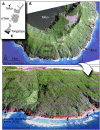The 2022 Hunga-Tonga megatsunami: Near-field simulation of a once-in-a-century event
- PMID: 37058570
- PMCID: PMC10104470
- DOI: 10.1126/sciadv.adf5493
The 2022 Hunga-Tonga megatsunami: Near-field simulation of a once-in-a-century event
Abstract
The Hunga Tonga-Hunga Ha'apai (HTHH) volcanic eruption in January 2022 generated catastrophic tsunami and contends for the largest natural explosion in more than a century. The main island, Tongatapu, suffered waves up to 17 m, and Tofua Island suffered waves up to 45 m, comfortably placing HTHH in the "megatsunami" league. We present a tsunami simulation of the Tongan Archipelago calibrated by field observations, drone, and satellite data. Our simulation emphasizes how the complex shallow bathymetry of the area acted as a low-velocity wave trap, capturing tsunami for more than 1 hour. Despite its size and long duration, few lives were lost. Simulation suggests that HTHH's location relative to urban centers saved Tonga from a worse outcome. Whereas 2022 seems to have been a lucky escape, other oceanic volcanoes have the capacity to spawn future tsunami at HTHH scale. Our simulation amplifies the state of understanding of volcanic explosion tsunami and provides a framework for assessment of future hazards.
Figures










References
-
- C. Timm, D. Bassett, I. J. Graham, M. I. Leybourne, C. E. J. de Ronde, J. Woodhead, D. Layton-Matthews, A. B. Watts, Louisville seamount subduction and its implication on mantle flow beneath the central Tonga–Kermadec arc. Nat. Commun. 4, 1720 (2013). - PubMed
-
- I. E. M. Smith, R. C. Price, The Tonga–Kermadec arc and Havre–Lau back-arc system: their role in the development of tectonic and magmatic models for the western Pacific. J. Volcanol. Geotherm. Res. 156, 315–331 (2006).
-
- F. Lavigne, J. Morin, P. Wassmer, O. Weller, T. Kula, A. V. Maea, K. Kelfoun, F. Mokadem, R. Paris, M. N. Malawani, A. Faral, M. Benbakkar, S. S. Copard, C. M. Vidal, T. Tu’I’afitu, F. Kitekei’aho, M. Trautmann, C. Gomez, Bridging legends and science: field evidence of a large tsunami that affected the Kingdom of Tonga in the 15th Century. Front. Earth Sci. 9, 10.3389/feart.2021.748755, (2021). - DOI
-
- C. Frohlich, M. J. Hornbach, F. W. Taylor, C. C. Shen, 'A. Moala, A. E. Morton, J. Kruger, Huge erratic boulders in Tonga deposited by a prehistoric tsunami. Geology 37, 131–134 (2009).
-
- M. Colombier, B. Scheu, F. B. Wadsworth, S. Cronin, J. Vasseur, K. J. Dobson, K. U. Hess, M. Tost, T. I. Yilmaz, C. Cimarelli, M. Brenna, B. Ruthensteiner, D. B. Dingwell, Vesiculation and quenching during surtseyan Eruptions at Hunga Tonga-Hunga Ha'apai Volcano, Tonga. J. Geophys. Res. Solid Earth 123, 3762–3779 (2018).
LinkOut - more resources
Full Text Sources

